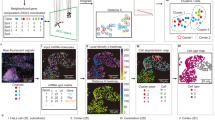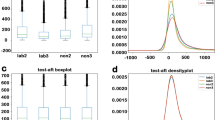Abstract
We describe an mRNA profiling technique for determining differential gene expression that utilizes, but does not require, prior knowledge of gene sequences. This method permits high-throughput reproducible detection of most expressed sequences with a sensitivity of greater than 1 part in 100,000. Gene identification by database query of a restriction endonuclease fingerprint, confirmed by competitive PCR using gene-specific oligonucleotides, facilitates gene discovery by minimizing isolation procedures. This process, called GeneCalling, was validated by analysis of the gene expression profiles of normal and hypertrophic rat hearts following in vivo pressure overload.
This is a preview of subscription content, access via your institution
Access options
Subscribe to this journal
Receive 12 print issues and online access
$209.00 per year
only $17.42 per issue
Buy this article
- Purchase on Springer Link
- Instant access to full article PDF
Prices may be subject to local taxes which are calculated during checkout





Similar content being viewed by others
References
Lee, N.H. et al. Comparative expressed-sequence-tag analysis of differential gene expression profiles in PC-12 cells before and after nerve growth factor treatment. Proc. Natl. Acad. Sci. USA 92, 8303– 8307 (1995).
Velculescu, V., Zhang, L., Vogelstein, B. & Kinzler, K. Serial analysis of gene expression. Science 270, 484–487 (1995).
Lee, S., Tomasetto, C. & Sager, R. Positive selection of candidate tumor-suppressor genes by subtractive hybridization. Proc. Natl. Acad. Sci. USA 88, 2825–2829 (1991).
Liang, P. & Pardee, A.B. Differential display of eukaryotic messenger RNA by means of the polymerase chain reaction. Science 257, 967–970 ( 1992).
Ivanova, N.B. & Belyavsky, A.V. Identification of differentially expressed genes by restriction endonuclease-based gene expression fingerprinting. Nucleic Acids Res. 23, 2954– 2958 (1995).
Kato, K. Description of the entire mRNA population by a 3´ end cDNA fragment generated by class IIS restriction enzymes. Nucleic Acids Res. 23 , 3685–3690 (1995).
Hubank, M. & Schatz, D.G. Identifying differences in mRNA expression by representational difference analysis of cDNA. Nucleic Acids Res. 22, 5640–5648 (1994).
Bachem, C.W.B., van der Hoeven, R.S., de Bruijin, S.M., Vreugdenhil, D., Zabeau, M. & Visser, R.G.F. Visualization of differential gene expression using a novel method of RNA fingerprinting based on AFLP: Analysis of gene expression during potato tuber development. Plant J. 9, 745– 753 (1996).
Schena, M., Shalon, D., Davis, R.W. & Brown, P.O. Quantitative monitoring of gene expression patterns with a complementary DNA microarray. Science 270, 467–470 ( 1995).
Lockhart, D.J. et al. Expression monitoring by hybridization to high-density oligonucleotide arrays. Nat. Biotechnol. 14, 1675– 1680 (1996).
Shalon, D., Smith, S.J. & Brown, P.O. A DNA microarray system for analyzing complex DNA samples using two-color fluorescent probe hybridization. Genome Res. 6, 639–645 ( 1996).
Wodicka, L., Dong, H., Mittmann, M., Ho, M.H. & Lockhart, D.J. Genome-wide expression monitoring in Saccharomyces cerevisiae. Nat. Biotechnol. 15, 1359 –1367 (1997).
DeRisi, J.L., Iyer, V.R. & Brown, P.O. Exploring the metabolic and genetic control of gene expression on a genomic scale. Science 278, 680– 686 (1997).
Milosavljevic, A. et al. DNA sequence recognition by hybridization to short oligomers: experimental verification of the method on the E. coli genome. Genomics 37, 77–86 ( 1996).
Milosavljevic, A., Strezoska, Z., Zeremski, M., Grujic, D., Paunesku, T. & Crkvenjakov, R. Clone clustering by hybridization. Genomics 27, 83–89 ( 1995).
Milosavljevic, A. et al. Discovering distinct genes represented in 29,570 clones from infant brain cDNA libraries by applying sequencing by hybridization methodology. Genome Res. 6, 132–141 (1996).
Drmanac, S. et al. Gene-representing cDNA clusters defined by hybridization of 57,419 clones from infant brain libraries with short oligonucleotide probes. Genomics 37, 29–40 ( 1996).
Chien, K.R., Knowlton, K.U., Zhu, H. & Chien, S. Regulation of cardiac gene expression during myocardial growth and hypertrophy: molecular studies of an adaptive physiologic response. FASEB J. 5, 3037–3046 (1991).
Boheler, K.R. & Schwartz, K. Gene expression in cardiac hypertrophy. Trends Cardiovasc. Med. 2, 176– 182 (1992).
Cooper, G. IV. Cardiocyte adaptation to chronically altered load. Ann. Rev. Physiol. 49, 501–518 ( 1987).
Weber, K.T. & Brilla, C.G. Pathological hypertrophy and cardiac interstitium: fibrosis and renin–angiotensin–aldosterone system. Circulation 83, 1849–1865 (1991).
Day, M. et al. Ventricular atriopeptin. Unmasking of messenger RNA and peptide synthesis by hypertrophy or dexamethasone. Hypertension 9, 485–491 (1987).
Izumo, S., Nadal-Ginard, B. & Mahdavi, V. Protooncogene induction and reprogramming of the cardiac gene expression produced by pressure overload. Proc. Natl. Acad. Sci. USA 85, 339–343 ( 1988).
Schiaffino, S. et al. Nonsynchronous accumulation of α-skeletal actin and β-myosin heavy chain mRNAs during early stages of pressure-overload-induced cardiac hypertrophy demonstrated by in situ hybridization. Circ. Res. 64, 937–948 (1989).
Schwartz, K., de la Bastie, D., Bouvaret, P., Oliviéro, P., Alonso, S. & Buckingham, M. α-Skeletal muscle actin mRNA's accumulate in hypertrophied adult rat hearts. Circ. Res. 59, 551– 555 (1986).
Samuel, J.L. et al. Accumulation of fetal fibronectin mRNAs during the development of rat cardiac hypertrophy induced by pressure overload. J. Clin. Invest. 88, 1737–1746 ( 1991).
Chapman, D., Weber, K.T. & Eghbali, M. Regulation of fibrillar collagen types I and III and basement membrane type IV collagen gene expression in pressure overloaded rat myocardium. Circ. Res. 67, 787– 794 (1990).
Schönherr, E., Witsch-Prehm, P., Harrach, B., Robenek, H., Rauterberg, J. & Kresse, H. Interaction of biglycan with type 1 collagen. J. Biol. Chem. 270, 2776–2783 (1995).
Bhalerao, J., Tylzanowksi, P., Filie, J.D., Kozak, C.A. & Merregaert, J. Molecular cloning, characterization, and genetic mapping of the cDNA coding for a novel secretory protein of mouse. J. Biol. Chem. 270, 16385– 16394 (1995).
Vanden Heuvel, G.B., Leardkamolkarn, V., St. John, P.L. & Abrahamson, D.R. Carboxy terminal sequence and synthesis of rat kidney laminin γ1 chain. Kidney Int. 49, 752–760 (1996).
Pepe, G. et al. A major involvement of the cardiovascular system in patients affected by Marfan syndrome: novel mutations in fibrillin 1 gene. J. Mol. Cell. Cardiol. 29, 1877–1884 ( 1997).
Engelmann, G., Campbell, S. & Rakusan, K. Immediate postnatal rat heart development modifed by abdominal aortic banding: analysis of gene expression. Mol. Cell. Biochem. 163–164, 47–56 (1996).
Sage, E.H. Terms of attachment: SPARC and tumorigenesis. Nat. Med. 3, 144–146 (1997).
Springhorn, J.P. & Claycomb, W.C. Preproenkephalin mRNA expression in developing rat heart and in cultured ventricular cardiac muscle cells. Biochem. J. 258, 73– 78 (1989).
Paradis, P., Dumont, M., Belichard, P., Rouleau, J.L., Lemaire, S. & Brakier-Gingras, L. Increased preproenkephalin A gene expression in the rat heart after induction of a myocardial infarction. Biochem. Cell Biol. 70, 593–598 ( 1992).
Anversa, P., Olivetti, G., Melissari, M. & Loud, A.V. Stereological measurement of cellular and subcellular hypertrophy and hyperplasia in the papillary muscle of adult rat. J. Mol. Cell. Cardiol. 12, 781–795 (1980).
Korecky, B. & Rakusan, K. Normal and hypertrophic growth of the rat heart: changes in cell dimensions and number. Am. J. Physiol. 234, H123–H128 ( 1978).
Boluyt, M.O. et al. Alterations in cardiac gene expression during the transition from stable hypertrophy to heart failure. Circ. Res. 75, 23–32 (1994).
Kimura, S., Bassett, A.L., Saida, K., Shimizu, M. & Myerburg, R.J. Sarcoplasmic reticulum function in skinned fibers of hypertrophied rat ventricle. Heart Circ. Physiol. 25, H1006–H1011 (1989).
Batra, S. & Rakusan, K. Capillarization of the hypertrophic heart: Discrepancy of the results obtained by the triangulation and domain methods. J. Cardiovasc. Pharmacol. 17 (Suppl 2), S151–S153 (1991).
Acknowledgements
The authors thank Dr. Richard Lifton for helpful comments on this manuscript, the Genentech in situ hybridization laboratories for technical assistance with anatomical pathology and Dr. Anne Ryan for interpretation of histopathology.
Author information
Authors and Affiliations
Corresponding author
Rights and permissions
About this article
Cite this article
Shimkets, R., Lowe, D., Tai, JN. et al. Gene expression analysis by transcript profiling coupled to a gene database query. Nat Biotechnol 17, 798–803 (1999). https://doi.org/10.1038/11743
Received:
Accepted:
Issue Date:
DOI: https://doi.org/10.1038/11743
This article is cited by
-
Identification and characterization of lysine-rich proteins and starch biosynthesis genes in the opaque2mutant by transcriptional and proteomic analysis
BMC Plant Biology (2013)
-
Treatment parameters modulating regression of human melanoma xenografts by an antibody–drug conjugate (CR011-vcMMAE) targeting GPNMB
Cancer Chemotherapy and Pharmacology (2007)
-
Cardiovascular genomics
Stem Cell Reviews (2006)
-
Genome-wide transcript analysis of maize hybrids: allelic additive gene expression and yield heterosis
Theoretical and Applied Genetics (2006)
-
Conversion of cDNA differential display results (DDRT-PCR) into quantitative transcription profiles
BMC Genomics (2005)



